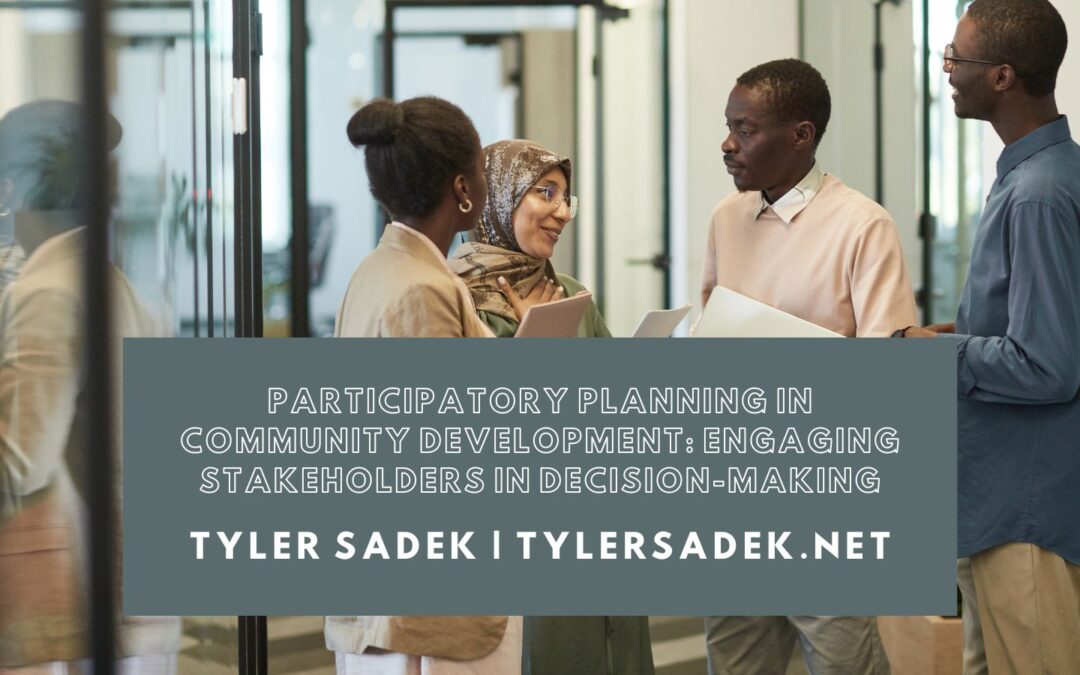Community development is a collaborative process aimed at improving the well-being of a community by addressing its unique needs and challenges. To achieve meaningful and sustainable outcomes, involving the community’s stakeholders in decision-making is essential. This approach, known as participatory planning, empowers community members to actively contribute to shaping their own future.
The Importance of Participatory Planning
Participatory planning is rooted in the belief that the people who live and work in a community are the experts on its strengths, weaknesses, and aspirations. Here are some reasons why participatory planning is crucial in community development:
- Empowerment: Engaging community members in the planning process empowers them to take ownership of the decisions that affect their lives. This empowerment fosters a sense of responsibility and accountability.
- Inclusivity: Participatory planning ensures that all community members’ voices, including those often marginalized or underrepresented, are heard and valued. It promotes social equity and inclusion.
- Local Knowledge: Community members possess valuable local knowledge about their environment, culture, and needs. This knowledge is essential for developing contextually relevant solutions.
- Sustainability: When community members actively participate in planning and decision-making, they are more likely to support and sustain the implemented projects or initiatives.
- Improved Outcomes: Participatory planning leads to better-informed decisions and more effective interventions, as they are grounded in the real experiences and needs of the community.
Principles of Participatory Planning
Effective participatory planning is guided by a set of principles that ensure meaningful and inclusive engagement:
- Inclusivity: Ensure that all community members, regardless of age, gender, socioeconomic status, or other factors, have the opportunity to participate.
- Transparency: Make the planning process transparent by sharing information, objectives, and outcomes with the community. Transparency builds trust and legitimacy.
- Respect and Equity: Treat all participants with respect and create an environment that values diverse perspectives. Strive for equitable representation and participation.
- Collaboration: Foster collaboration among community members, local organizations, government agencies, and other stakeholders. Collaboration enhances the collective capacity for problem-solving.
- Capacity Building: Invest in building the skills and knowledge of community members to actively participate in planning and decision-making processes.
- Adaptability: Be flexible and adaptable to changing circumstances and evolving community needs. Recognize that plans may need to adjust over time.
Methods of Participatory Planning
Several methods and tools can be employed to facilitate participatory planning in community development:
- Community Meetings and Workshops: Organize meetings and workshops where community members can discuss issues, set priorities, and brainstorm solutions collectively.
- Focus Groups: Small group discussions can provide a more comfortable setting for participants to express their views and concerns.
- Surveys and Questionnaires: Distribute surveys or questionnaires to gather feedback and input from a broader segment of the community.
- Participatory Mapping: Community members can create maps highlighting important local features, resources, and challenges. This visual representation aids in planning and decision-making.
- Storytelling and Oral History: Encourage community members to share their personal experiences and narratives to inform planning processes.
- Design Charrettes: These intensive planning sessions bring together experts, stakeholders, and the community to collaborate on the design of specific projects or areas.
- Participatory Budgeting: Allow community members to allocate a portion of the budget to projects or initiatives they prioritize.
- Social Media and Online Platforms: Use digital tools and platforms to engage a wider audience and facilitate virtual participation.
Case Studies in Participatory Planning
Participatory planning has been successfully applied in various community development initiatives worldwide. Here are a few case studies that highlight its impact:
- Porto Alegre, Brazil: Porto Alegre is renowned for its participatory budgeting program, where residents actively allocate a portion of the city’s budget. This approach has led to improved infrastructure and increased citizen involvement in governance.
- Kerala, India: Kerala’s community-based water resource management is a participatory planning model. Local communities are involved in water allocation, conservation, and distribution decision-making.
- Portland, Oregon, USA: Portland’s neighborhood association system empowers residents to participate in land-use planning and development decisions, promoting community-led development.
- Rwanda’s Ubudehe Program: The Ubudehe Program uses community consultations and participation to determine poverty levels and allocate government resources accordingly, enabling more targeted poverty reduction efforts.
- UNICEF’s U-Report: U-Report is a global messaging platform that allows young people to express their opinions on issues affecting their communities. It has been used in over 70 countries to engage youth in decision-making.
Conclusion
Participatory planning in community development is not a one-size-fits-all approach but a mindset that prioritizes inclusivity, collaboration, and empowerment. Successful participatory planning hinges on a commitment to transparency, respect, and adaptability, ensuring that the resulting initiatives truly reflect the needs and aspirations of the communities they aim to serve. In a world facing complex challenges, participatory planning stands as a beacon of hope, reminding us that the best solutions often emerge from the collective wisdom and creativity of those most directly affected by them.

